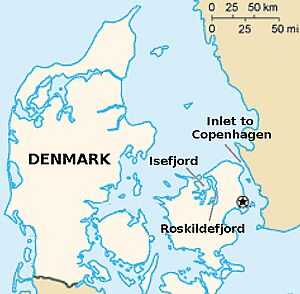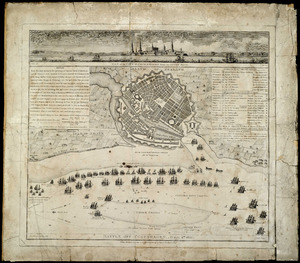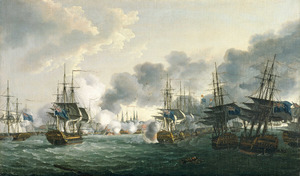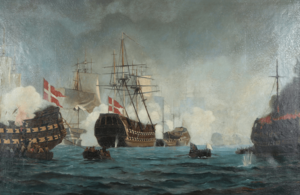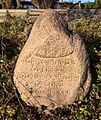Battle of Copenhagen (1801) facts for kids
Quick facts for kids First Battle of Copenhagen |
|||||||
|---|---|---|---|---|---|---|---|
| Part of the War of the Second Coalition and the English Wars | |||||||
 Battle of Copenhagen by Nicholas Pocock |
|||||||
|
|||||||
| Belligerents | |||||||
| Commanders and leaders | |||||||
|
|
||||||
| Strength | |||||||
|
|
||||||
| Casualties and losses | |||||||
|
1,200 killed, wounded or captured 3 ships of the line ran aground |
|
||||||
The Battle of Copenhagen of 1801 was a big naval battle. It happened on April 2, 1801. A British fleet fought and defeated a smaller Danish-Norwegian fleet. The battle took place near Copenhagen, the capital of Denmark–Norway.
Britain was worried that the powerful Danish fleet might join forces with France. Talks between the two countries broke down. This led to the battle.
British ships entered the harbor where the Danish fleet was. Danish ships and land forts defended the city. This was the second time Britain tried to stop Denmark from allying with France. The Danes eventually agreed to British terms. This happened when they heard that the Russian leader, Tsar Paul I of Russia, had died. His death meant the end of a group called the Second League of Armed Neutrality, which Denmark was part of.
Contents
Why the Battle Happened
The battle happened because of problems in diplomacy. In early 1801, during the French Revolutionary Wars, Britain had the strongest navy. The British Royal Navy would stop neutral ships trading with French ports. They would take goods if they thought the ships were helping France. Britain wanted to keep its strong navy and its trade advantages.
The Russian Tsar, Paul I, had been a British friend. But then he formed a group called the Second League of Armed Neutrality. This group included Denmark, Sweden, Prussia, and Russia. They wanted to make sure trade with France was free. Britain saw this group as a big threat. They thought it would help France and stop Britain from getting important wood and supplies from Scandinavia.
The British Fleet Sets Sail
In early 1801, the British government gathered a fleet of ships. Their goal was to break up this new group of countries. Britain needed to act before the Baltic Sea ice melted. If the Russian fleet joined with the Swedish and Danish fleets, they would form a very strong force. This combined force could have up to 123 large warships.
The British fleet was led by Admiral Hyde Parker. Vice Admiral Horatio Nelson was his second-in-command. Nelson was impatient with delays. He sent a letter to a friend, which made the fleet sail from Yarmouth on March 12. Parker was ordered to go to Copenhagen. He had to get Denmark to leave the group, either peacefully or by fighting. After that, he was to attack the Russians.
The British fleet reached the Skaw (Skagen) on March 19. There, a British diplomat told them that Denmark had refused their demands.
Admiral Parker was a careful leader and moved slowly. Nelson wanted to ignore Denmark and Sweden. He wanted to sail directly to the Baltic Sea to fight the Russians. In the end, Nelson convinced Parker to attack the Danish fleet near Copenhagen. Sweden had promised naval help to Denmark, but it never arrived. Prussia had very few ships and could not help either.
On March 30, the British ships sailed through the narrow waters between Denmark and Sweden. They stayed close to the Swedish coast to avoid Danish guns. Luckily for the British, the Swedish forts did not fire.
Danish Defenses
Attacking the Danish fleet was hard. Parker's delay had given the Danes time to prepare. Most Danish ships were not ready to sail. Instead, they were anchored along the shore. Old ships, called hulks, were used as floating batteries. These were placed in front of the city in the King's Channel.
The northern end of the Danish line ended at the Tre Kroner forts. This fort had 68 guns. North of the fort, two warships, a large frigate, and two smaller ships were ready. Land batteries also covered the water. A large sandbank, the Middle Ground, made the channel narrow. The British did not have good maps. So, Captain Thomas Hardy spent a night checking the water depth. Even so, some British ships still went too far out.
The Battle Begins
Getting Ready for the Fight
Parker gave Nelson the twelve ships that sat shallowest in the water. He also gave him all the smaller ships. Parker stayed to the north-east with the heavier ships. These deeper ships could not safely enter the channel. Parker's ships protected Nelson from outside attacks. Nelson moved his command from a large 98-gun ship to a shallower 74-gun ship, HMS Elephant.
On March 30, Nelson and his second-in-command, Rear Admiral Thomas Graves, checked the Danish defenses. They found the defenses were strong. Guns on land were stronger than ship guns because they were more stable. The Danes could also send more men to their ships during the battle. However, the Danish ships were a mix of different types, and many were small.
Nelson's plan was for British ships to approach the weaker, southern end of the Danish defenses. They would line up parallel to the Danish ships. Each British ship would anchor next to a Danish ship and start firing. Other ships would pass by until they found their target.
A frigate, HMS Desirée, and small gun-brigs would fire along the Danish line from the south. A group of frigates would attack the northern end. Troops would land and attack the Tre Kroner fort after the ships were defeated. Bomb vessels would stay behind the British line and fire over it. If the British could not defeat the strong northern defenses, destroying the southern ships would let the bomb vessels get close enough to bombard the city. This would force the Danes to talk.
The Fight Starts
On April 2, with a southerly wind, Nelson's ships carefully moved through the shallow areas. But HMS Agamemnon got stuck before entering the channel. It could not join the battle. Then HMS Russell and HMS Bellona also got stuck on the Middle Ground. This greatly limited their role. Losing these three ships meant quick changes were needed and weakened the British northern force.
The Danish forts started firing at 10:05 am. Half of the British fleet was fighting in about 30 minutes. By 11:30 am, the battle was in full swing. Once the British line was in place, there was little movement. British ships anchored about a ship's length from the Danish line. They exchanged fire until a ship stopped firing. The British faced strong resistance. This was partly because they had not seen some low-lying floating batteries. It was also because the Danes fought very bravely. The northern Danish ships, which were ready to sail, did not join the battle. They stayed as reserve units.
At 1:00 pm, the battle was still intense. The Danish ship Prøvesteenen was firing heavily. It would have destroyed HMS Isis if Desirée had not fired along its length. HMS Monarch was badly damaged by fire from Holsteen and Sjælland.
Nelson's "Blind Eye"
Admiral Parker could not see much of the battle because of the smoke. But he saw distress signals from the three grounded British ships. He thought Nelson might be stuck and unable to retreat without orders. Navy rules said all ranks must "do their utmost" against the enemy. So, at 1:30 pm, Parker told his captain: "I will make the signal of recall for Nelson's sake. If he is in condition to continue the action, he will disregard it; if he is not, it will be an excuse for his retreat and no blame can be imputed to him."
Nelson ordered that the signal be seen, but not repeated. He turned to his captain, Thomas Foley, and said, "You know, Foley, I only have one eye — I have the right to be blind sometimes." Then, holding his telescope to his blind eye, he said, "I really do not see the signal!" Rear Admiral Graves repeated the signal, but in a place where most other ships could not see it. He kept Nelson's "close action" signal flying. Only Captain Riou, who could not see Nelson's ship, followed Parker's signal. Riou pulled his ships back, exposing them to heavy fire. He was killed, along with several of his crew.
The Battle Ends
At this point, the battle turned in favor of the British. Their better gunnery started to make a difference. The guns of the southernmost Danish ships began to fall silent. The fighting moved northward. By 2:00 pm, many Danish guns had stopped firing. This allowed the British bomb vessels to get closer to Copenhagen. Also, the Danish land batteries became less effective.
The Danish ship Nyborg tried to leave the line but sank. The frigate Hjælperen successfully retreated. The Danish commander, Commodore Olfert Fischer, moved from his burning ship Dannebrog to Holsteen. When Indfødsretten surrendered around 2:30 pm, he moved to the Tre Kroner fort. There, he fought three of Parker's ships that had drifted into range. Indfødsretten started firing again after a new captain took command.
Some Danish ships fired on British boats sent to them after they had surrendered. Nelson said he had to stop this "irregular proceeding." He went to his cabin to write a note to the Danes. He sent it with an officer who spoke Danish, under a white flag. The note was for the Danish ruler, Crown Prince Frederik. It said:
To the Brothers of Englishmen, the Danes
Lord Nelson has directions to spare Denmark when she is no longer resisting, but if firing is continued on the part of Denmark, Lord Nelson will be obliged to set on fire the floating batteries he has taken, without having the power of saving the brave Danes who have defended them.—Nelson
All fighting stopped when Crown Prince Frederick sent his Adjutant General, Hans Lindholm, to ask why Nelson sent the letter. Lindholm joked, "If your guns are not better pointed than your pens, then you will make little impression on Copenhagen."
Nelson replied:
Lord Nelson's object in sending the Flag of Truce was humanity; he therefore consents that hostilities shall cease, and that the wounded Danes may be taken on shore. And Lord Nelson will take his prisoners out of the Vessels, and burn and carry off his prizes as he shall see fit.
Lord Nelson, with humble duty to His Royal Highness the Prince of Denmark, will consider this the greatest victory he has ever gained, if it may be the cause of a happy reconciliation and union between his own most gracious Sovereign, and His Majesty the King of Denmark.—Nelson
A 24-hour ceasefire was agreed upon.
After the Battle
After the fighting, the Danish flagship Dannebrog exploded at 4:30 pm. This killed 250 men. By the end of the afternoon, three more British ships ran aground. These included Nelson's ship, Elephant.
Many Danish-Norwegian ships were manned by volunteers. These volunteers had little or no naval experience. So, it is hard to know the exact number of Danish-Norwegian losses. Estimates range from 1,135 to 2,215 killed, wounded, or captured. The official report said between 1,600 and 1,800. British casualties were 963 killed and wounded.
Of the Danish ships that fought, two sank, one exploded, and twelve were captured. The British could not spare men to sail all the captured ships. They burned eleven of them. Only one, Holsteen, was sailed to England with the wounded. Holsteen was later used by the British Royal Navy.
What Happened Next
The next day, Nelson went to Copenhagen to start talks. He met with the Crown Prince for two hours. Nelson was able to get an agreement to stop fighting for an unknown period. He tried to convince the Danes to accept British protection against the Russians.
Negotiations continued. On April 8, Nelson returned with a formal agreement. One difficult point was a 16-week ceasefire to allow action against the Russians. Nelson said they were "ready to bombard this very night!" if there was disagreement. Apologies followed, and an agreement was signed the next day. The ceasefire was for 14 weeks. During this time, the armed neutrality would stop. The British would have free access to Copenhagen. Danish prisoners were also released.
During the final talks, the Danes found out that Tsar Paul had been killed. This meant the League of Armed Neutrality broke up. This allowed the Danes to accept the British terms. The final peace agreement was signed on October 23, 1801.
On April 12, Parker sailed to Karlskrona, Sweden. The Swedish fleet returned to port. Parker tried to convince them to leave the League too. Parker then returned to Copenhagen. News of his slow actions had reached London. On May 5, he was called back. Nelson took over his command. Nelson sailed east again. He found that the ice had melted, and the Russian fleet had left. He also found that talks to end the armed neutrality had begun. So, he left on May 17. Because of this battle, Lord Nelson was given the noble title of Viscount Nelson of the Nile.
This was not the end of the conflict between Denmark-Norway and Britain. In 1807, similar events led to another British attack. This was the Second Battle of Copenhagen.
Ships Involved
United Kingdom
- Nelson's Squadron
- HMS Polyphemus 64 guns
- HMS Isis 50 guns
- HMS Edgar 74 guns
- HMS Ardent 64 guns
- HMS Glatton 54/56 guns
- HMS Elephant 74 guns (Nelson's ship)
- HMS Ganges 74 guns
- HMS Monarch 74 guns
- HMS Defiance 74 guns
- HMS Russell 74 guns
- HMS Bellona 74 guns
- HMS Agamemnon 64 guns
- HMS Desiree 36 guns
- HMS Amazon 38 guns
- HMS Blanche 36 guns
- HMS Alcmene 32 guns
- Template:French corvette Perçante (1795) 24 guns
- HMS Arrow (sloop)
- HMS Dart (sloop)
- HMS Cruizer (brig-sloop)
- HMS Harpy (brig-sloop)
- HMS Discovery (bomb vessel)
- HMS Explosion (bomb vessel)
- HMS Hecla (bomb vessel)
- HMS Sulphur (bomb vessel)
- HMS Terror (bomb vessel)
- HMS Volcano (bomb vessel)
- HMS Zebra (bomb vessel)
- HMS Otter (fireship)
- HMS Zephyr (fireship)
- Parker's Reserve
- HMS London 98 guns (Parker's ship)
- HMS St George 98 guns
- HMS Warrior 74 guns
- HMS Defence 74 guns
- HMS Saturn 74 guns
- HMS Ramillies 74 guns
- HMS Raisonnable 64 guns
- HMS Veteran 64 guns
Denmark-Norway
- Fischer's Division in the King's Deep
- Prøvesteenen 52/56 guns
- Wagrien 48/52 guns
- Jylland 48/54 guns
- Dannebrog 64 guns (flagship)
- Sjælland 74 guns
- Holsteen 64 guns
- Indfødsretten 64 guns
- Rendsborg 20 guns
- Nyborg 20 guns
- Sværdfisken 18/20 guns
- Kronborg 22 guns (frigate)
- Hajen 18/20 guns
- Elven 10 guns (frigate)
- Flådebatteri No. 1 20 guns (Floating Battery)
- Aggershus 20 guns (defense vessel)
- Charlotte Amalia 26 guns (Old East Indiaman)
- Søehesten 18 guns
- Hielperen 16 guns (defense frigate)
- Fortifications
- Sea battery TreKroner - 68 guns
- Sea Battery Lynetten
- Land battery Sixtus
- Land battery Quintus
- Fortress Kastellet
Legacy
The death of Tsar Paul of Russia changed the political situation. This made the battle less important in terms of diplomacy. The ships lost were not a huge blow to either navy's overall strength. However, the battle showed that Britain was determined to keep its navy the strongest in the war against France.
Images for kids
See also
- List of Danish ships captured at Battle of Copenhagen
- Bibliography of 18th-19th century Royal Naval history


